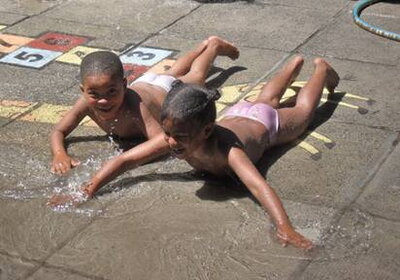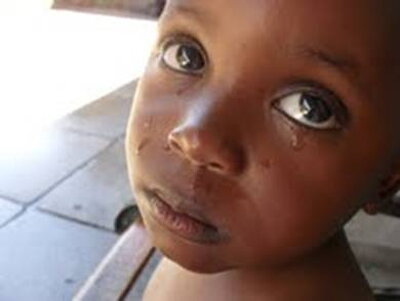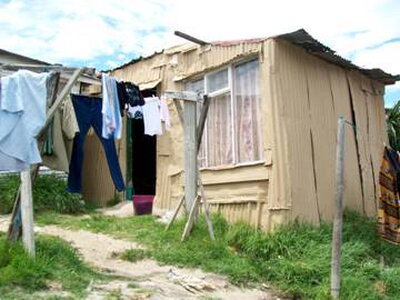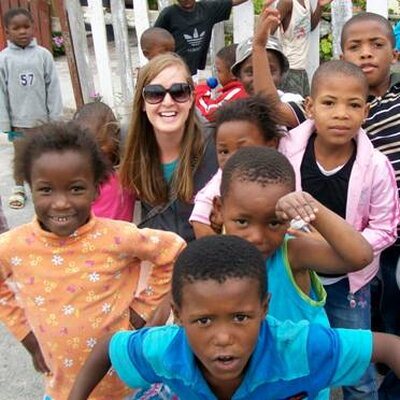
(Jan Brooks of the Department of Human and Community Development led the HDFS 398 Cape Town Study Abroad/Volunteer Experience trip at winter break again this year. The pre-departure course ran the last 8 weeks of the fall semester and the trip ran from Dec. 28 through Jan. 18. The group stayed in Cape Town for tours and volunteer work and spent a weekend touring historical sites and museums in Johannesburg, including a bicycle tour of the historic township of Soweto, site of a famous rebellion in 1976 which sparked the phase of the anti-apartheid movement which brought the country to democracy in 1994. Here we publish two students’ accounts of their visits. )
Lessons from African Sunflowers
By Diandra Entler

Helping children in Africa: it has become a stereotype in modern times. People from across the world, young and old alike, flock to various parts of Africa with the intention of helping children. They hear stories of children with HIV and other incurable diseases and assume pain and suffering is plentiful and want to help. They give their time, energy and money to help the children of the world hurt just a little less. I was that person, and came to South Africa with those same intentions.
In addition to wanting to help, I also came to Africa to learn. I am currently studying to become a Child Life Specialist. Child Life is a career field that helps to accommodate the psychosocial needs of children in the hospital setting. I felt that work in Africa with sick children would be valuable to my education and better prepare me for my field of study. My experience proved invaluable and I gained wonderful insight and preparation but not nearly in the way I expected.
My assignment was at St. Joseph’s Home for Chronically Ill Children. The home has a variety of wards based on the age and diagnoses of the children. I was placed in the Sunflower ward where I worked with HIV positive children from ages 0-6. I walked in my first day, armed with sympathy and prepared for the worst. To my surprise, I was greeted with smiles and laughter which continued all day, for every day I was there. The children of the Sunflower ward play with this incredibly infectious energy and passion for life. They each know that they are sick but only allow their illness to be a minimal part of their life.
Now, I am in no way romanticizing or lessening the gravity of HIV or any illness. However, after my time with the children of the Sunflower ward, I learned several things. People across the world, different cultures, races, religions, are much more alike than they are different. We all need and want the same things. These children don’t need sympathy, tears or money. More than anything they need an opportunity to be kids. They are children before they are ever patients. They need to play in the dirt, explore and use their imagination in the wildest ways; and that is exactly what we did. So, I stopped feeling sorry. I stopped feeling guilty and the urge to want to “help” them. They don’t need that. I can’t cure their body, and maybe no one can, but, I can absolutely cure their spirit.

I have included two photographs with this article that I feel best capture what I gained from my time at St. Joseph’s Home. The first one is one of the children of the Sunflower ward with tears dripping down his cheeks. I chose this particular photograph because it is strikingly similar to photographs used on rice bowls and on TV ads that reinforce the stereotype of the African child. Having taken the photograph, it is almost comical the reason for such grief and challenges the stereotype with great strength. He isn’t hungry, or in pain; he is actually crying because he is afraid of the sprinkler on the playground. The kids of Sunflower grew to adore the sprinkler and played in it for hours to help cool off on hot days. Sibusiso ( boy photographed ) did not like the sprinkler and was quite terrified of it and therefore kept me company while others played.
The second photograph I included is of two children from the Sunflower ward, Apewe and Averencia, playing in a puddle of water. The children loved to play in the water that pooled on the ground from the sprinkler. They splashed and played until the water was gone. All of the children of this ward were full of such happiness and smiled often. I feel that this photo best represents their energy and ardor and helps illustrate the careless, limitless joy that only a child can truly have.
This assignment was designed for me to share the experience I had and would therefore be incomplete if I did not include the following. I came to Cape Town so drained after such a demanding year. I had lost passion for my work and was completely overwhelmed. The trip itself really restored the things I had lost in the chaos of the last year. Yet, it was the children I worked with who taught me how to live my life in a more fulfilling way; to play more and worry less. All fifteen of them touched me in a different way. I am liberated and revived. I have regained my passion for school and work and can honestly say that those children helped me more than I ever could have helped them. I am so grateful for this experience and will continue to implement the lessons learned from my fifteen sunflowers.
Impressions of Visiting Townships in South Africa

On my trip to Cape Town, South Africa, all the things I did were new, exciting, and overall amazing, but one thing in particular really stuck out to me. Our tours of the townships in the area were an incredible, life changing experience that I hope to never forget.
We went to several townships, and the first one was Imizamo Yethu. Seeing these shacks made out of scrap metal and realizing that they are peoples’ homes was very surreal. They said that 22-30 families, not just people, all share four toilets! It really made me realize how much I take for granted. At first a lot of us on the trip felt kind of awkward, like we were being rude and intruding by taking pictures of their poverty and poor conditions, however we soon realized that was not the case. We were encouraged to take pictures and ask questions; they were glad we were there and it meant a lot to them that we would come and see a little of what their life is like. Having us there and seeing their situation meant they were getting recognition. Someone else was noticing their suffering and might tell more people, and then more help might come.
When I say “their suffering,” please don’t picture them as dirty, sad, and hopeless. These people, though they have very little, are full of hope and pride. You won’t see anyone walking around in dirty, torn clothes. They wash and iron their clothes and want to look and feel their best, just like you and I. They look out for their children, families, and even others in their neighborhood and the community. The little time I spent in these townships I saw preschools, churches, health clinics, orphanages, and even resource centers with free information and computer use to help out the people around them. They do not have a lot, but they use what they do have to the best of their ability to improve their lives. The problem is, even if they have a steady job and paycheck, it is extremely difficult for them to obtain enough money to be able to get themselves much better off.

As we walked down the street of another township, Khayelitsha, and were welcomed with kind words and tons of smiles, I was absolutely amazed. I felt so appreciated by both adults and children, and it was incredibly humbling. These people have so little that they are appreciative of me just visiting their town. It was definitely a different experience, but a really good one.
Seeing the people in the townships made me realize that I want to be more like them. I want to welcome everyone I meet with a smile and a gracious heart, no matter who they are or how long they’ll be in my life; I want to appreciate every little thing and not take it for granted; and I want to keep my head up in all situations, work hard, and never give up hope.